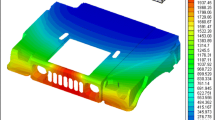Abstract
The flow behaviors of the resin during the resin transfer molding (RTM) process of sisal fiber reinforced composites was studied at different scales with the consideration of the unique hierarchical and lumen structures of sisal fibers compared to those of manmade fibers. The work mainly focused on the development of the multi-scale flow models which include the resin flow inside lumens, intra-bundles and inter-bundles. The models not only quantified the lumen flow based on the Hagen-Poiseuille equation, but also ensured the continuity of the velocity and stress on the boundaries between intra-bundle and inter-bundle regions by applying Brinkman equation. Three dedicated experiments were designed and implemented to validate the effectiveness of the proposed models. The absorbed resin mass over the infiltration time obtained from the single sisal fiber and sisal fiber bundle infiltration experiments showed good agreement with the calculated curves. In terms of the RTM process, the dynamic flow front of the resin was perfectly predicted by the proposed model at macro-scale.
Similar content being viewed by others
References
Faruk O, Bledzki A K, Fink H P, et al. Biocomposites reinforced with natural fibers: 2000–2010. Prog Polymer Sci, 2000, 37: 1552–1596
Pickering K L, Efendy M G A, Le T M. A review of recent developments in natural fibre composites and their mechanical performance. Compos Part A-Appl S, 2016, 83: 98–112
Satyanarayana K G, Arizaga G G C, Wypych F. Biodegradable composites based on lignocellulosic fibers—An overview. Prog Polymer Sci, 2009, 34: 982–1021
Li Y, Luo Y, Han S. Multi-scale structures of natural fibres and their applications in making automobile parts. J Biobased Mat Bioenergy, 2010, 4: 164–171
Carman P C. Fluid flow through granular beds. Chem Eng Res Des, 1997, 75: S32–S48
Bruschke M V, Advani S G. Flow of generalized newtonian fluids across a periodic array of cylinders. J Rheology, 1993, 37: 479–498
Skartsis L, Khomami B, Kardos J L. Resin flow through fiber beds during composite manufacturing processes. Part II: Numerical and experimental studies of Newtonian flow through ideal and actual fiber beds. Polym Eng Sci, 1992, 32: 231–239
Gebart B R. Permeability of unidirectional reinforcements for RTM. J Compos Mater, 1992, 26: 1100–1133
Ranganathan S, Phelan F R, Advani S G. A generalized model for the transverse fluid permeability in unidirectional fibrous media. Polym Composite, 1996, 17: 222–230
Brinkman H C. A calculation of the viscous force exerted by a flowing fluid on a dense swarm of particles. Appl Sci Res, 1949, 1: 27
Francucci G, Rodríguez E S, Morán J. Novel approach for mold filling simulation of the processing of natural fiber reinforced composites by resin transfer molding. J Compos Mater, 2014, 48: 191–200
Masoodi R, Pillai K M. Darcy’s law-based model for wicking in paper-like swelling porous media. Aiche J, 2010, 56: 2257–2267
Nguyen V H, Deléglise-Lagardère M, Park C H. Modeling of resin flow in natural fiber reinforcement for liquid composite molding processes. Compos Sci Tech, 2015, 113: 38–45
Stuart T, McCall R D, Sharma H S S, et al. Modelling of wicking and moisture interactions of flax and viscose fibres. Carbohyd Polym, 2015, 123: 359–368
Francucci G, Rodríguez E S, Vázquez A. Study of saturated and unsaturated permeability in natural fiber fabrics. Compos Part A-Appl S, 2010, 41: 16–21
Rodriguez E, Giacomelli F, Vazquez A. Permeability-porosity relationship in RTM for different fiberglass and natural reinforcements. J Compos Mater, 2004, 38: 259–268
Ameri E, Lebrun G, Laperrière L. In-plane permeability characterization of a unidirectional flax/paper reinforcement for liquid composite molding processes. Compos Part A-Appl S, 2016, 85: 52–64
Rong M Z, Zhang M Q, Liu Y, et al. The effect of fiber treatment on the mechanical properties of unidirectional sisal-reinforced epoxy composites. Compos Sci Tech, 2001, 61: 1437–1447
Patel N, Rohatgi V, Lee L J. Micro scale flow behavior and void formation mechanism during impregnation through a unidirectional stitched fiberglass mat. Polym Eng Sci, 1995, 35: 837–851
Jiang X, Zhou Z, Yao J, et al. Micro-fluid flow in microchannel. In: The 8th International Conference on Solid-State Sensors and Actuators and Eurosensors IX. Stockholm, 1995. 317–320
Binétruy C, Hilaire B, Pabiot J. The interactions between flows occurring inside and outside fabric tows during rtm. Compos Sci Tech, 1997, 57: 587–596
Bernet N, Michaud V, Bourban P E, et al. An impregnation model for the consolidation of thermoplastic composites made from commingled yarns. J Compos Mater, 1999, 33: 751–772
Lawrence J M, Neacsu V, Advani S G. Modeling the impact of capillary pressure and air entrapment on fiber tow saturation during resin infusion in lcm. Compos Part A-Appl S, 2009, 40: 1053–1064
Dimitrovova Z, Advani S G. Analysis and characterization of relative permeability and capillary pressure for free surface flow of a viscous fluid across an array of aligned cylindrical fibers. J Colloid Interf Sci, 2002, 245: 325–337
Foley M E, Gillespie Jr J W. Modeling the effect of fiber diameter and fiber bundle count on tow impregnation during liquid molding processes. J Compos Mater, 2005, 39: 1045–1065
Amico S, Lekakou C. Flow through a two-scale porosity, oriented fibre porous medium. Transp Porous Media, 2004, 54: 35–53
Ahn K J, Seferis J C, Berg J C. Simultaneous measurements of permeability and capillary pressure of thermosetting matrices in woven fabric reinforcements. Polym Composite, 1991, 12: 146–152
Phelan Jr F R, Wise G. Analysis of transverse flow in aligned fibrous porous media. Compos Part A-Appl S, 1996, 27: 25–34
Shou D H, Ye L, Fan J T. Longitudinal permeability determination of dual-scale fibrous materials. Compos Part A-Appl S, 2015, 68: 42–46
Author information
Authors and Affiliations
Corresponding author
Rights and permissions
About this article
Cite this article
Yin, T., Li, Y. & Yuan, B. The multi-scale flow behaviors of sisal fiber reinforced composites during resin transfer molding process. Sci. China Technol. Sci. 61, 1925–1934 (2018). https://doi.org/10.1007/s11431-018-9343-5
Received:
Accepted:
Published:
Issue Date:
DOI: https://doi.org/10.1007/s11431-018-9343-5




